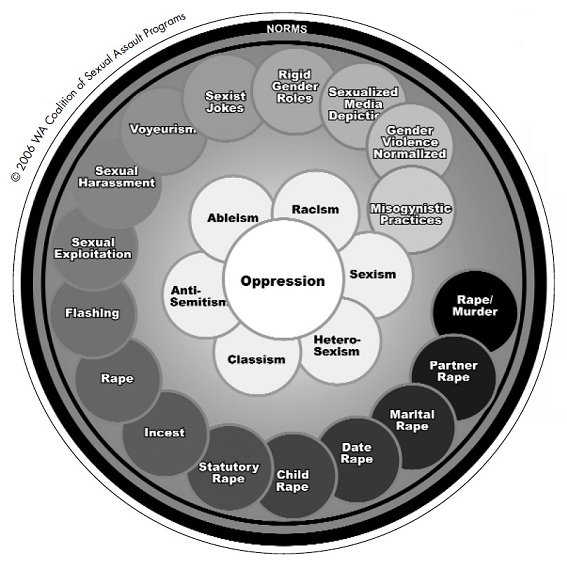Even Men Get Raped
Talks with S
11/23/2012
Today, society is well versed with the notion that women all over the world can be, and are, sexually assaulted or raped. Over the last few years, the idea that “even men can be raped” has come to surface; however, it is a fairly new and untapped ideology. The questions that may arise in the minds of people are, “who rapes men?” or “how can a man be raped in the first place? aren’t men strong enough to protect themselves?” In addition, society is still not well equipped- socially, medically nor legislatively- to “handle” men getting raped. The women’s resource center of Georgia College, defines “rape” from the Georgia Law Book as a situation when a “male” forcibly penetrates a “female’s” sex organ. According to this Georgia Law Book,
“A person commits the offense of rape when he has carnal knowledge of:
(1) A female forcibly and against her will; or
(2) A female who is less than ten years of age.
Carnal knowledge in rape occurs when there is any penetration of the female sex organ by the male sex organ. The fact that the person allegedly raped is the wife of the defendant shall not be a defense to a charge of rape.”
This definition of rape stems from the traditional view of a heterosexual relationship- where men were having sexual intercourse with women only, and vice versa. Since “manhood” has always identified men to be physically stronger than women, it was always assumed that only men could rape women. The concept of women raping men, although is not rare, has very seldom been reported. Even though the concept of homosexuality is not new, society has not fully integrated this “new model” in society. Thus men, sexually assaulting other men is a relatively new concept that can be fully addressed only once society fully acknowledges (comes to “positive” terms with it) the existence of homosexual or bisexual relationships. Archer, Davies and Walker, in Effects of Rape on Men: A Descriptive Analysis, talk about men getting raped by other men, and the negative effects the victims suffer as a consequence.
I wanted to take a moment to provide the definition of terms such as “aggravated sodomy” and “sexual battery” to then better explain how the concept of “men getting raped or sexually assualted by other men,” has been made space for in the legal system in the U.S.
With effect from 2001, “Aggravated Sodomy” is a concept that addresses men getting sexually assaulted. The ‘Lectric Law Library, in Georgia Sexual Offences, states,
“A person commits the offense of sodomy when he performs or submits to any sexual act involving the sex organs of one person and the mouth or anus of another. A person commits the offense of aggravated sodomy when he commits sodomy with force and against the will of the other person.”
Furthermore, the term “sexual battery” also addresses both “males” and “females” getting sexually assaulted. The Georgia Law Book states,
“A person commits the offense of sexual battery when he or she intentionally makes physical contact with the intimate parts of the body of another person without the consent of that person. The term “intimate parts” means the primary genital area, anus, groin, inner thighs, or buttocks of a male or female and the breasts of a female.”
As of January 2012, the Obama Administration expanded the definition of sex crimes. The revised FBI definition states,
“rape is ‘the penetration, no matter how slight, of the vagina or anus with any body part or object,’ without the consent of the victim. Also constituting rape under the new definition is ‘oral penetration by a sex organ of another person’ without consent.”
This definition uses the term “another individual” or “victim” that can refer to both men and women.
Although the legal system may have extended it’s definition to include men as potential victims of sexual assault, this wasn’t the case at the time of the research study published by Archer, Davies and Walker, in Effects of Rape on Men: A Descriptive Analysis. At that time (though it may still occur today as well), the police or the judicial system looked down upon men who got raped. This research study mentioned in Effects of Rape on Men: A Descriptive Analysis, draws out such instances of male victims. Archer, Davies and Walker state, “Very few male rape victims report their assault to the police because they think that they will experience negative treatment, be disbelieved, or blamed for their assault” (495). Several victims found the police to be unsympathetic, disinterested, and homophobic. They found the police not to take their complaint seriously, and therefore many victims regretted informing the police of the sexual assault (Archer, Davies and Walker 500). One victim who responded to the study by Archer, Davies and Walker, was able to bring himself to justice convicting his penetrator of the crime he had committed. Despite this, the victim described his experience in court as distressful, and even as “leaving a worse effect on him than the rape itself” (Archer, Davies and Walker 500).
Archer, Davies and Walker state,
“As majority of male rape victims cannot fight back, self blame for not doing so may contribute to the victim failing to seek medical help from the police, medical sources or friends and family.” (503).
Raped- male victims suffer various negative effects as a result of their “experience”.This includes self-blame for “allowing” this to happen to themselves, as they believed to have put themselves in such situations where they may have trusted a stranger or acquaintance, or for inability to fight back, or for punishment for being homosexual, etc. (Archer, Davies and Walker 502). The long-term effects of being assaulted also include, but may not be limited to: suffering from severe depression, anxiety in interactions with other men, increased sense of vulnerability, lowered dignity and pride, lowered self-worth, erection failure and lack of libido, confusion about sexual orientation- say now engaging in homosexual activity, bulimia and excessive alcoholic consumption, attempted suicide, etc. (Archer, Davies and Walker 496, 500, 501 & 502).
These long-term effects result from two main aspects of the victim’s sexual assault- the reactions of the victim “during” the assault, and “immediately after” reactions of the society after the assault. While some men were able to put up a fight, majority of the men who participated in the study stated that they were unable to put up a fight. The reactions of these men “during” the assault included feelings of fear and helplessness. Archer, Davies and Walker, in Effects of Rape on Men: A Descriptive Analysis stated, “ these men reported that the sense of helplessness and loss of control during the assault was worse than the sexual aspects of the encounter” (499). The “immediately after” reactions pertain to the societal reactions that these men believed themselves to have faced. These men fall victim to the personal and societal “secondary victimization”, as they were expected to have been “manly” enough to have saved themselves (Archer, Davies and Walker 503). In addition to the various long-term effects mentioned above, various victims may even begin to question whether they can protect their families or loved ones.
The results of the study conducted in “Effects of Rape on Men: A Descriptive Analysis”, concluded that only one man considered himself to have fully recovered from the assault, and 8 out of the 40 participants defined themselves as having not recovered at all since the assault. This recovery, if at all, was largely due to passing-of time, psychological treatment, prescribed medication, support from medical staff and other persons who actually believed their story (Archer, Davies and Walker 500 & 502). Archer, Davies and Walker state, “In general, the most helpful aspects of the treatments included being told it was not their fault, having someone to talk to, and someone to listen and express care and concern” (500).
The American College Health Association Guidelines on Primary Prevention of Sexual Violence on college campuses that we read for this class last week was from the viewpoint of protection of females from sexual assault. Prevention methods to avoid sexual assault, and support groups for raped victims were traditionally addressed only towards women’s safety and health. It is estimated that the help and support for male victims of rape is more than 20 years behind that of female victims (Archer, Davies and Walker 495). The participants of the study in “Effects of Rape on Men: A Descriptive Analysis”, knew that the public is not well aware about male rape victims. Archer, Davies and Walker state,
“When asked why they had participated in the study, responses focused on promoting informed publicity about male rape. For example, men said that they responded to the advertisement [about participation in this study] to try to help professionals understand male rape and what victims experience, to bring male rape to the attention of the public, to help future victims, and to establish support for male victims…” (500).
Currently, women have several 24- hour help lines, rape crisis centers, and support groups available to them. The same needs to be opened for men as well. Currently men can call RAINN’s National Sexual Assault Hotline 24/7 for help, find a therapist or participate in discussion forums organized by “male survivor” and can even seek help from “1in6” online help support for men. Several other such forums need to be opened for male survivors. Furthermore, the police and other professionals need to be more empathetic and less homophobic towards male victims, the laws should fully incorporate punishment for sexual misconduct of a man by one (or more) other man, the American College Health Association should have a guideline outlining primary prevention methods for sexual violence against men, and loved ones need to be explained how to react to male victim’s when they confide their experience in them. The first step required here is education of society. Only once society is aware that both men and women are potential victims of rape can male victims be open about having been raped. This will help the victims to avoid long- term “post- rape trauma”, allow them to freely get themselves testing for STD’s that they may have contracted during their rape, be upfront with others about their “experience”, and press legal charges against perpetrators without fear of being judged by society.
Citations:
1in6. “Get Help”
http://1in6.org/men/get-help/
American College Health Association (ACHA Guidelines). “Shifting the Paradigm: Primary Prevention of Sexual Violence”
Archer, John. Davies, Michelle. Walker, Jayne. “Effects of Rape on Men: A Descriptive Analysis”
Georgia College. Women’s Resource Centre. “Sexual Assault” http://www.gcsu.edu/womenscenter/projectcare/sexualassault.htm
Huff Post. “Men As Rape Victims: Obama Administration Expands Definition Of Sex Crime”
http://www.huffingtonpost.com/2012/01/07/men-as-rape-victims-_n_1191154.html
Male Survivor. “Overcoming Male Victimization of Boys and Men”
http://www.malesurvivor.org/
RAINN. “Male Sexual Assault”
http://www.rainn.org/get-information/types-of-sexual-assault/male-sexual-assault
The ‘Lectric Law Library. “Georgia Sexual Offences”
http://www.lectlaw.com/files/sex06.htm


